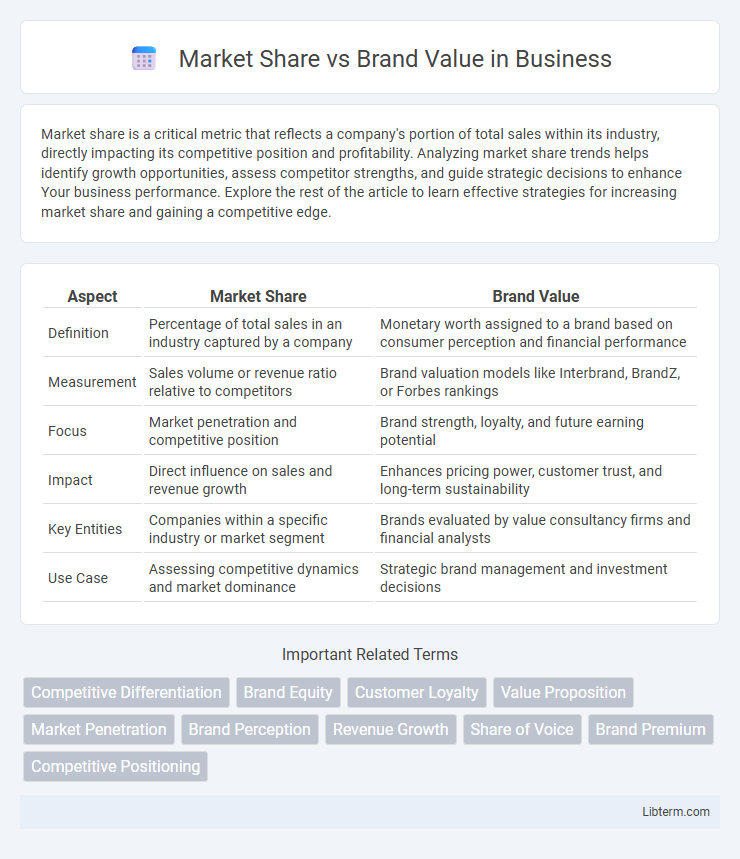Market share is a critical metric that reflects a company's portion of total sales within its industry, directly impacting its competitive position and profitability. Analyzing market share trends helps identify growth opportunities, assess competitor strengths, and guide strategic decisions to enhance Your business performance. Explore the rest of the article to learn effective strategies for increasing market share and gaining a competitive edge.
Table of Comparison
| Aspect | Market Share | Brand Value |
|---|---|---|
| Definition | Percentage of total sales in an industry captured by a company | Monetary worth assigned to a brand based on consumer perception and financial performance |
| Measurement | Sales volume or revenue ratio relative to competitors | Brand valuation models like Interbrand, BrandZ, or Forbes rankings |
| Focus | Market penetration and competitive position | Brand strength, loyalty, and future earning potential |
| Impact | Direct influence on sales and revenue growth | Enhances pricing power, customer trust, and long-term sustainability |
| Key Entities | Companies within a specific industry or market segment | Brands evaluated by value consultancy firms and financial analysts |
| Use Case | Assessing competitive dynamics and market dominance | Strategic brand management and investment decisions |
Understanding Market Share: Definition and Importance
Market share represents the percentage of total sales in an industry captured by a company, serving as a critical indicator of competitive position and customer preference. It directly reflects a company's ability to attract and retain customers within its market segment, influencing strategic decisions and resource allocation. High market share often correlates with economies of scale, pricing power, and increased bargaining leverage, essential for sustaining long-term business growth and profitability.
Defining Brand Value: Key Components
Brand value is defined by a combination of tangible and intangible components such as customer loyalty, perceived quality, and brand recognition, which directly influence a company's competitive advantage. Market share measures the percentage of sales a company holds in its industry, but brand value encapsulates the overall worth derived from consumer perception and emotional connection. Core components like brand equity, brand awareness, and consistent brand messaging drive long-term profitability beyond mere sales volume.
Market Share vs Brand Value: Core Differences
Market share measures a company's sales volume relative to the total market, reflecting competitive position and customer acquisition. Brand value quantifies the financial worth of a brand's reputation and customer loyalty, influencing long-term profitability and market strength. The core difference lies in market share indicating current market presence while brand value captures intangible assets driving future growth and consumer preference.
How Market Share Influences Brand Value
Market share directly influences brand value by reflecting customer preference, competitive strength, and market dominance, which attract investor confidence and consumer trust. Higher market share often leads to increased revenue streams and economies of scale, enhancing profitability and enabling stronger investment in marketing and innovation. This cycle bolsters brand equity, making the brand more recognizable and desirable in the marketplace.
Factors Affecting Market Share
Market share is influenced by factors such as product quality, pricing strategies, and distribution channels that determine a company's ability to capture and retain customers within a specific market. Competitive landscape and consumer preferences play crucial roles in shaping market share by impacting demand and brand visibility. Effective marketing campaigns and innovation also drive market share growth by enhancing customer engagement and differentiating products from competitors.
Drivers of Strong Brand Value
Strong brand value is driven by factors such as customer loyalty, emotional connection, consistent quality, and effective brand positioning. Market share influences brand value but high brand equity often results from unique brand experiences and perceived value rather than just sales volume. Companies with strong innovation, reputation management, and customer engagement sustain superior brand value regardless of their market share fluctuations.
Case Studies: Companies with High Market Share but Low Brand Value
Companies like Xiaomi and Walmart illustrate the divergence between high market share and low brand value, with Xiaomi dominating smartphone sales globally but facing challenges in premium brand perception and Walmart leading in retail sales while struggling with brand affinity compared to competitors. Market share reflects volume and penetration, whereas brand value measures consumer perception, loyalty, and premium pricing potential. This disparity impacts marketing strategies, as firms must balance volume-driven growth with initiatives to enhance brand equity and long-term profitability.
Case Studies: Brands with Strong Value but Limited Market Share
Several luxury fashion brands, such as Hermes and Rolex, exhibit high brand value despite limited global market share due to their exclusive product offerings and heritage. These brands leverage scarcity and craftsmanship to maintain premium pricing and customer loyalty, differentiating themselves from mass-market competitors. Their case studies highlight the strategic focus on brand equity over volume, proving that strong brand value can drive profitability without extensive market penetration.
Strategies to Balance Market Share and Brand Value
Effective strategies to balance market share and brand value focus on enhancing customer experience while maintaining competitive pricing to increase market penetration. Investing in innovation and consistent brand messaging strengthens brand equity, supporting long-term customer loyalty without diluting the brand's perceived quality. Leveraging data analytics to understand consumer behavior enables targeted marketing efforts that optimize both market share growth and brand value preservation.
Measuring Success: Market Share Metrics vs Brand Value Metrics
Market share metrics quantify a company's competitive position by calculating the percentage of total sales captured within an industry, providing a clear indicator of market dominance. Brand value metrics assess the intangible assets related to customer loyalty, brand recognition, and perceived quality, often measured through brand equity studies, financial valuation models, or consumer preference surveys. Combining market share data with brand value insights delivers a comprehensive view of business success, balancing quantitative sales performance with qualitative brand strength.
Market Share Infographic

 libterm.com
libterm.com